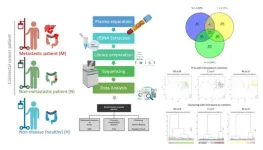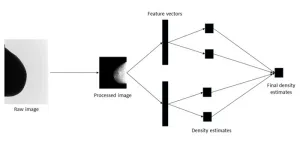(Press-News.org) Statement Highlights:
A new American Heart Association scientific statement reviews research about racial and ethnic differences in cardiovascular risk factors among women in the U.S.
In addition to traditional risk factors, women of underrepresented races or ethnicities experience challenges in the diagnosis and treatment of cardiovascular conditions due to language barriers, discrimination, difficulties in acculturation or assimilation, lack of financial resources or health insurance, or lack of access to health care.
Women of racial and ethnic backgrounds other than white have been underrepresented in research, therefore, current risk calculators have limitations for Black, Hispanic/Latina, American Indian/Alaska Native and Asian women in the U.S.
Expanding cardiovascular risk assessment calculators to include social determinants of health and non-biological variables is necessary to address cardiovascular disease among women of underrepresented races or ethnicities.
Embargoed until 4 a.m. CT / 5 a.m. ET Monday, April 10, 2023
DALLAS, April 10, 2023 — Non-biological factors and social determinants of health are important to include in CVD risk assessment for women, particularly for women of diverse races and ethnicities other than white, according to a new American Heart Association scientific statement published today in Circulation, the Association’s flagship, peer-reviewed journal.
“Risk assessment is the first step in preventing heart disease, yet there are many limitations to traditional risk factors and their ability to comprehensively estimate a woman’s risk for cardiovascular disease,” said Jennifer H. Mieres, M.D., FAHA, vice chair of the scientific statement writing committee and a professor of cardiology at the Zucker School of Medicine at Hofstra Northwell in Hempstead, N.Y. Of note, large patient data registries used to develop cardiovascular risk assessment formulas or algorithms lack racial and ethnic diversity, so they may not accurately reflect risk for women of underrepresented groups.
A 2022 American Heart Association presidential advisory deemed it critical to understand the impact of race and ethnicity on cardiovascular risk factors in women in order to incorporate those specific risks into prevention plans and reduce the high burden of CVD among women from diverse backgrounds. This new scientific statement responds to the presidential advisory as a review of the current evidence on racial and ethnic differences in cardiovascular risk factors for women in the U.S.
What traditional risk formulas miss about women in general
Traditional formulas to determine cardiovascular disease risk include Type 2 diabetes, blood pressure, cholesterol, family history, smoking status, physical activity level, diet and weight. These formulas do not account for sex-specific biological influences on cardiovascular risk or medications and conditions that are more common among women than men.
Female-specific factors that should be included in assessing cardiovascular risk are:
Pregnancy-related conditions, such as preeclampsia (dangerous high blood pressure that develops late in pregnancy), preterm delivery, gestational diabetes, gestational high blood pressure or miscarriage. According to the Association of Black Cardiologists, 2 out of 3 women who experience preeclampsia will die of heart disease.
Menstrual cycle history, such as age at first period and at menopause.
Types of birth control and/or hormone replacement therapy used.
History of chemotherapy or radiation therapy.
Polycystic ovarian syndrome (PCOS) – a condition that results in hormone imbalance and irregular ovulation. PCOS affects up to 10% of women of reproductive age and is associated with higher risk for cardiovascular disease.
Autoimmune disorders – women are twice as likely as men to develop autoimmune disorders such as rheumatoid arthritis or lupus. These conditions are associated with faster build-up of plaque in the arteries, higher risk of cardiovascular disease and worse outcomes after heart attacks and strokes.
Depression and posttraumatic stress disorder – both are more common among women and associated with a higher risk of developing CVD.
“The delivery of equitable cardiovascular health care for women depends on improving the knowledge and awareness of all members of the health care team about the full spectrum of cardiovascular risk factors for women, including female-specific and female-predominant risk factors,” said Mieres, who is also the chief diversity and inclusion officer at Northwell Health.
Importance of social determinants of health in risk assessment
Social determinants of health play a significant role in the development of CVD among women, with disproportionate effects on women from diverse racial and ethnic backgrounds. These determinants include economic stability, neighborhood safety, working conditions, environmental hazards (such as exposure to air pollution), education level and access to quality health care. The impact of social factors is recognized in how they affect behavioral risk factors, such as smoking status, physical activity, diet and proper medication use.
“It is critical that risk assessment be expanded to include social determinants of health as risk factors if we are to improve health outcomes in all women,” said Laxmi S. Mehta, M.D., FAHA, chair of the writing group and director of preventative cardiology and women’s cardiovascular health at The Ohio State University Wexner Medical Center in Columbus, Ohio. “It is also important for the health care team to consider social determinants of health when working with women on shared decisions about cardiovascular disease prevention and treatment.”
Differences in women’s cardiovascular disease risk by race and ethnicity
Although cardiovascular disease is the leading cause of death for all women, the statement highlights significant racial and ethnic differences in cardiovascular risk profiles:
Non-Hispanic Black women (an umbrella term encompassing African American, African and Caribbean) in the U.S. have the highest prevalence of high blood pressure in the world, above 50%. They are also more likely to develop Type 2 diabetes; have obesity or extreme obesity; and to die of smoking-related diseases. Non-Hispanic Black women are disproportionately affected by traditional risk factors and experience the onset of CVD at younger ages. Social determinants of health are a key driver for this disparity, as detailed in the AHA’s 2022 Cardiovascular Disease Statistical Update.
Hispanic/Latina women (referring to women of any racial and ethnic background whose ancestry is from Mexico, Central America, South America, the Caribbean or other Spanish-speaking countries) have a higher rate of obesity compared with Hispanic/Latino men. Hispanic/Latina women born in the U.S. also have higher rates of smoking than those who were born in another country and immigrated to the U.S. Paradoxically, despite higher rates of Type 2 diabetes, obesity and metabolic syndrome, CVD death rates are 15-20% lower in Hispanic/Latina women than among non-Hispanic white women. It’s possible that this “Hispanic paradox” is due to grouping diverse Hispanic subcultures together in research data, which does not account for different levels of risk among individual subgroups of Hispanic/Latino people or the possibility of healthy immigrant bias.
American Indian and Alaska Native women (a diverse population including hundreds of federally recognized and non-recognized tribes across the U.S.) have a higher rate of tobacco use than other groups, with 1 in 3 American Indian or Alaska Native women currently smoking. Type 2 diabetes is the primary risk factor for heart disease among American Indian women; however, rates vary by region, with up to 72% prevalence among American Indian women in Arizona, and just over 40% among those in Oklahoma, North Dakota and South Dakota. Unfortunately, understanding the cardiovascular health of American Indian/Alaska Native people is challenging due to small sample sizes in national data, racial and/or ethnic misclassification or other factors.
Asian American women (having origins in the Far East, Southeast Asia or the Indian subcontinent) have varied rates of CVD risk within Asian subgroups: high blood pressure rates are 30% among Chinese women and 53% among Filipino women; rates of low HDL (good) cholesterol and high triglycerides are highest among Asian Indian and Filipino women; and Type 2 diabetes prevalence is highest among Southeast Asian women. The BMI level for increased risk of Type 2 diabetes is lower for Asian people than for other racial groups. Asian Americans are less likely to be overweight or have obesity compared to other racial groups, however, at the same BMI they have higher rates of high blood pressure, CVD and Type 2 diabetes. Higher body fat levels and the distribution of body fat may explain these differences: Recent research shows that Asian people generally have a higher percentage of body fat than non-Hispanic white people of the same age, sex and body mass index. In addition, studies have shown that Chinese, Filipino and Asian Indian people have more abdominal fat compared with non-Hispanic white and Black people.
“When customizing CVD prevention and treatment strategies to improve cardiovascular health for women, a one-size-fits-all approach is unlikely to be successful,” Mieres said. “We must be cognizant of the complex interplay of sex, race and ethnicity, as well as social determinants of health, and how they impact the risk of cardiovascular disease and adverse outcomes in order to avert future CVD morbidity and mortality.”
Future cardiovascular disease prevention guidelines may be strengthened by urging culturally specific lifestyle recommendations tailored to the cultural norms and expectations that influence behaviors, beliefs and attitudes about diet, physical activity and healthy weight, according to the statement. The writing committee calls for community-based approaches, faith-based community partnerships and peer support in encouraging a healthy lifestyle to improve the primary prevention of cardiovascular disease among women from underrepresented groups. The statement also urges more research to address gaps in our knowledge about risk factors among women, including gathering data specific to subgroups of each race and ethnicity.
This scientific statement was prepared by the volunteer writing group on behalf of the American Heart Association’s Cardiovascular Disease and Stroke in Women and Underrepresented Populations Committee of the Council on Clinical Cardiology; the Council on Cardiovascular and Stroke Nursing; the Council on Hypertension; the Council on Lifelong Congenital Heart Disease and Heart Health in the Young; the Council on Lifestyle and Cardiometabolic Health; the Council on Peripheral Vascular Disease; and the Stroke Council. American Heart Association scientific statements promote greater awareness about cardiovascular diseases and stroke issues and help facilitate informed health care decisions. Scientific statements outline what is currently known about a topic and what areas need additional research. While scientific statements inform the development of guidelines, they do not make treatment recommendations. American Heart Association guidelines provide the Association’s official clinical practice recommendations.
Additional co-authors are Gladys P. Velarde, M.D., FAHA; Jennifer Lewey, M.D., M.P.H.; Garima Sharma, M.D.; Rachel M. Bond, M.D.; Ana Navas-Acien, M.D., Ph.D.; Amanda M. Fretts, M.P.H., Ph.D.; Gayenell S. Magwood, Ph.D., R.N., FAHA; Eugene Yang, M.D.; Roger S. Blumenthal, M.D., FAHA; and Rachel-Maria Brown, M.D. Authors’ disclosures are listed in the manuscript.
The Association receives funding primarily from individuals. Foundations and corporations (including pharmaceutical, device manufacturers and other companies) also make donations and fund specific Association programs and events. The Association has strict policies to prevent these relationships from influencing the science content. Revenues from pharmaceutical and biotech companies, device manufacturers and health insurance providers, and the Association’s overall financial information are available here.
Additional Resources:
Available multimedia is on the right column of news release link https://newsroom.heart.org/news/non-biological-factors-and-social-determinants-of-health-important-in-womens-cvd-risk-assessment?preview=3d73aff57d41d526637bcd8f03ccace9
After April 10, view the manuscript online.
Spanish news release
Chinese news release (doc)
AHA news releases:
Does risk for heart disease start before birth? (Feb. 2023)
Limited post-partum follow-up may miss high blood pressure in 1 in 10 new moms (Nov. 2022)
Social vulnerabilities linked to cardiometabolic risk during pregnancy (Oct. 2022)
Investment, action urged to improve access, quality and equity in women’s heart health (May 2022)
Follow AHA/ASA news on Twitter @HeartNews
About the American Heart Association
The American Heart Association is a relentless force for a world of longer, healthier lives. We are dedicated to ensuring equitable health in all communities. Through collaboration with numerous organizations, and powered by millions of volunteers, we fund innovative research, advocate for the public’s health and share lifesaving resources. The Dallas-based organization has been a leading source of health information for nearly a century. Connect with us on heart.org, Facebook, Twitter or by calling 1-800-AHA-USA1.
###
END
Non-biological factors and social determinants of health important in women’s CVD risk assessment
A new American Heart Association scientific statement notes that current CVD risk assessments fall short for women from diverse races and ethnicities other than white
2023-04-10
ELSE PRESS RELEASES FROM THIS DATE:
Study finds record-breaking rates of sea-level rise along the U.S. Southeast and Gulf coasts
2023-04-10
Sea levels along the U.S. Southeast and Gulf coasts have been rapidly accelerating, reaching record-breaking rates over the past 12 years, according to a new study led by scientists at Tulane University.
In the study, published in Nature Communications, researchers said they had detected rates of sea-level rise of about a half an inch per year since 2010. They attribute the acceleration to the compounding effects of man-made climate change and natural climate variability.
“These rapid rates are unprecedented over at least the 20th century and they have been three times higher than the global average over the same period,” says Sönke ...
New guidelines on catatonia aim to create a step-change in management
2023-04-10
For the first time, the British Association for Psychopharmacology (BAP) has produced a guideline on catatonia. Catatonia is a severe psychiatric disorder that has been associated with a wide range of medical complications. Yet recognition and management remain poor.
Twenty-two experts from across three continents examined the latest research on this important condition and have developed a series of recommendations ranging from diagnosis and investigation to treatment. According to the lead author, Dr Jonathan Rogers of University ...
Targeted testing for HIV in hospital emergency departments has great potential, Spanish researchers say
2023-04-10
**Note: the release below is a special early release from the European Congress of Clinical Microbiology & Infectious Diseases (ECCMID 2023, Copenhagen, 15-18 April). Please credit the conference if you use this story**
Embargo: 2301H UK time Sunday 9 April
**Note – the press release is available in Spanish and Portuguese, see links below**
Targeted testing for HIV in emergency departments has great potential for increasing diagnoses, this year’s European Congress of Clinical Microbiology & Infectious Diseases (ECCMID) in Copenhagen, Denmark, (15-18 April), will ...
Engineered plants produce sex perfume to trick pests and replace pesticides
2023-04-10
By using precision gene engineering techniques, researchers at the Earlham Institute in Norwich have been able to turn tobacco plants into solar-powered factories for moth sex pheromones.
Critically, they’ve shown how the production of these molecules can be efficiently managed so as not to hamper normal plant growth.
Pheromones are complex chemicals produced and released by an organism as a means of communication. They allow members of the same species to send signals, which includes letting others know they’re looking for love.
Farmers can hang pheromone dispersers among their crops to mimic the signals ...
Future is bright for gold-based antibiotics
2023-04-08
**Note: the release below is a special early release from the European Congress of Clinical Microbiology & Infectious Diseases (ECCMID 2023, Copenhagen, 15-18 April). Please credit the conference if you use this story**
Embargo: 2301H UK time Friday 7 April
New research being presented at this year’s European Congress of Clinical Microbiology & Infectious Diseases (ECCMID) in Copenhagen, Denmark, (15-18 April) has identified several gold-based compounds with the potential to treat multidrug-resistant “superbugs”.
With ...
How to see the invisible: Using the dark matter distribution to test our cosmological model
2023-04-07
It feels like a classical paradox: How do you see the invisible? But for modern astronomers, it is a very real challenge: How do you measure dark matter, which by definition emits no light?
The answer: You see how it impacts things that you can see. In the case of dark matter, astronomers watch how light from distant galaxies bends around it.
An international team of astrophysicists and cosmologists have spent the past year teasing out the secrets of this elusive material, using sophisticated computer simulations and the observations from the one of the most powerful astronomical cameras in the world, the Hyper Suprime-Cam (HSC). The team is led by astronomers from Princeton ...
Four different autism subtypes identified in brain study
2023-04-07
People with autism spectrum disorder can be classified into four distinct subtypes based on their brain activity and behavior, according to a study from Weill Cornell Medicine investigators.
The study, published March 9 in Nature Neuroscience, leveraged machine learning to analyze newly available neuroimaging data from 299 people with autism and 907 neurotypical people. They found patterns of brain connections linked with behavioral traits in people with autism, such as verbal ability, social affect, and repetitive or stereotypic behaviors. They confirmed that the four autism subgroups could also be replicated in a separate dataset ...
New method of clustering colorectal cancer patients using DPE sequencing
2023-04-07
“[...] DPE analysis may have an important role in improving the diagnosis and management of CRC.”
BUFFALO, NY- April 7, 2023 – A new editorial paper was published in Oncoscience (Volume 10) on March 23, 2023, entitled, “New method of clustering colorectal cancer patients using differential presence of exons (DPE) sequencing.”
Colorectal cancer (CRC) is a heterogeneous disease that occurs in the colon and the rectum, parts of the gastrointestinal system. CRC is the third leading cause of cancer-related ...
Deep learning model estimates cancer risk from breast density
2023-04-07
Breast cancer is the most common cancer to affect women worldwide. According to the American Cancer Society, about 1 in 8 women in the United States will develop breast cancer in their lifetime. While it is not possible to entirely prevent breast cancer, various medical organizations advise regular screening to detect and treat cases at the early stage. The breast density, defined as the proportion of fibro-glandular tissue within the breast, is often used to assess the risk of developing breast cancer. While various methods are available to estimate this measure, studies have shown that subjective assessments conducted by radiologists based on visual analogue scales ...
COVID-19 pandemic increased the frequency of intimate partner violence
2023-04-07
Lesbian, gay, bisexual, transgender and queer people who experienced intimate partner violence in their current relationship before COVID-19 had an increase in the frequency of victimization after the pandemic began, according to a Rutgers study.
While national emergencies, crises and pandemics increase the frequency of health risks and intimate partner violence few studies have considered the nuances of social and psychological factors, such as socioeconomic characteristics and mental health, in explaining the increase in intimate partner violence during times of crisis.
“To date, most programs on intimate ...
LAST 30 PRESS RELEASES:
Why nail-biting, procrastination and other self-sabotaging behaviors are rooted in survival instincts
Regional variations in mechanical properties of porcine leptomeninges
Artificial empathy in therapy and healthcare: advancements in interpersonal interaction technologies
Why some brains switch gears more efficiently than others
UVA’s Jundong Li wins ICDM’S 2025 Tao Li Award for data mining, machine learning
UVA’s low-power, high-performance computer power player Mircea Stan earns National Academy of Inventors fellowship
Not playing by the rules: USU researcher explores filamentous algae dynamics in rivers
Do our body clocks influence our risk of dementia?
Anthropologists offer new evidence of bipedalism in long-debated fossil discovery
Safer receipt paper from wood
Dosage-sensitive genes suggest no whole-genome duplications in ancestral angiosperm
First ancient human herpesvirus genomes document their deep history with humans
Why Some Bacteria Survive Antibiotics and How to Stop Them - New study reveals that bacteria can survive antibiotic treatment through two fundamentally different “shutdown modes”
UCLA study links scar healing to dangerous placenta condition
CHANGE-seq-BE finds off-target changes in the genome from base editors
The Journal of Nuclear Medicine Ahead-of-Print Tip Sheet: January 2, 2026
Delayed or absent first dose of measles, mumps, and rubella vaccination
Trends in US preterm birth rates by household income and race and ethnicity
Study identifies potential biomarker linked to progression and brain inflammation in multiple sclerosis
Many mothers in Norway do not show up for postnatal check-ups
Researchers want to find out why quick clay is so unstable
Superradiant spins show teamwork at the quantum scale
Cleveland Clinic Research links tumor bacteria to immunotherapy resistance in head and neck cancer
First Editorial of 2026: Resisting AI slop
Joint ground- and space-based observations reveal Saturn-mass rogue planet
Inheritable genetic variant offers protection against blood cancer risk and progression
Pigs settled Pacific islands alongside early human voyagers
A Coral reef’s daily pulse reshapes microbes in surrounding waters
EAST Tokamak experiments exceed plasma density limit, offering new approach to fusion ignition
Groundbreaking discovery reveals Africa’s oldest cremation pyre and complex ritual practices
[Press-News.org] Non-biological factors and social determinants of health important in women’s CVD risk assessmentA new American Heart Association scientific statement notes that current CVD risk assessments fall short for women from diverse races and ethnicities other than white



